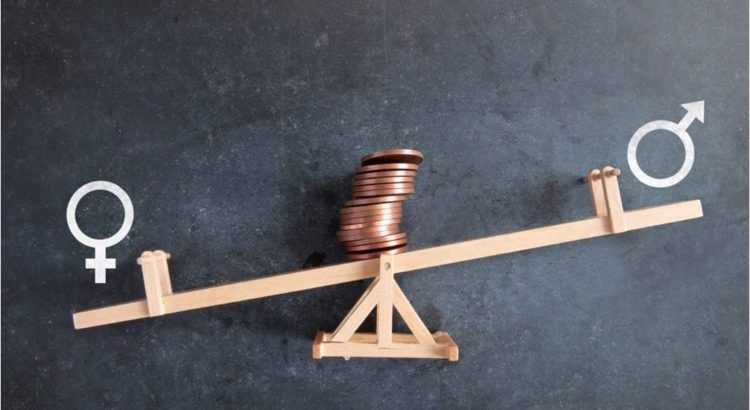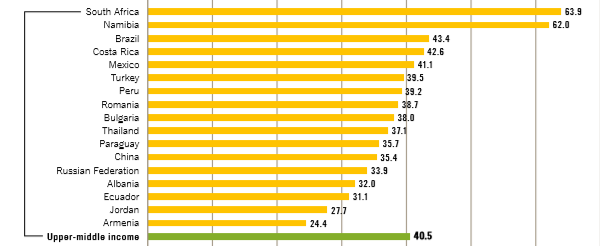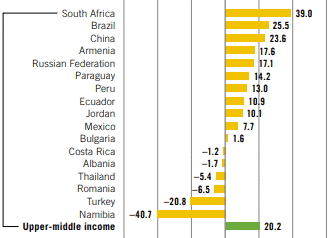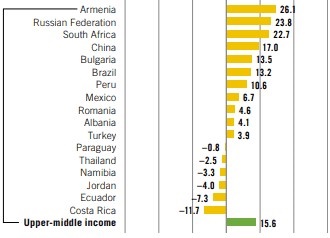By: Vuyelwa Dantjie.
South Africa’s gender pay gap represents one of today’s many social injustices as shown by the ILO Global Wage report’s 2018/19 interesting statistics.
Covering 70 countries and 80% of wage employees worldwide, the report shows that on average women continue to be paid 28% less than men.
This is an alarming percentage, what is more alarming is that South Africa has the world’s highest wage inequality overall – the distribution of wealth between the rich and the poor.
Using the survey data, the ILO Global Wage report has calculated inequality in wages and represents the information using the Gini Coefficient as shown in graph 1.
The Gini Coefficient is used as a gauge of economic inequality; it measures income distribution and wealth distribution among a population – values closer to zero indicate lower levels of wage inequality and values closer to 100 indicate higher levels of wage inequality.
Graph 1: Inequality as measured by the Gini Coefficient around the World
Source: Global Wage Report 2018/19
According to the graph above South Africa, Namibia, the United Republic of Tanzania and Malawi are the African countries with the highest values of wage inequality among the countries considered.
Here South Africa has been classified in the upper-middle income sector and scored a Gini Coefficient of 63.9.
Although high, this statistic might be explained given our context and history. It could for example be attributed to the legacy of South Africa’s history, which resulted in exclusionary policies.
This played a role in establishing inequalities in wage distribution through the practice of unfair discrimination.
The Constitution sought to address inequality through section 9 in Chapter 2 of the Bill of Rights, which provides for equality and equal protection of the law to everyone.
The Employment Equity Act 55 of 1998 was since introduced to protect and advance persons, or categories of persons who were disadvantaged by unfair discrimination.
The act places responsibility onto the employer for reducing inequality in wage distribution and the South African government endorses equal pay for equal work and proposes it as a principle to reduce inequality.
The labour department is currently legislating the mandatory reporting of various equal pay reports to try to arrest the inequality of pay.
21st Century, the largest remuneration consultancy in South Africa, provides organisations with equal pay reports, which contains a number of statistical analyses, which include:
• Wage gap;
• 10-10 Ratio;
• Palma Ratio;
• Gini Coefficient and Lorenz curve;
• Pay differentials by gender and race; and
• Inequity within jobs.
Reports such as these are the first step in attempting to manage pay equity within organisations.
Gender pay gap statistics in South Africa
The Global Wage Report 2018/19 gives a break down into full time and part-time work and illustrates how women are prejudiced in the employment market as shown in graph 2 and graph 3.
Graph 2: Full-time workers pay disparity between women and men
Source: Global Wage Report 2018/19
South African women who are permanently employed earn 22.7% less than men do.
Graph 3: Part-time workers pay disparity between women and men
Source: Global Wage Report 2018/19
South African women who work part-time earn 39% less than men do. South Africa came in as the second worst country surveyed for part-time wage inequality; Pakistan came in at 77.4%.
Can we come up with any explanations?
Do men earn more because they are more educated?
There is no real evidence that the level of education alters the gender pay gap. Looking at the score in education figure below we can see that females are as educated as males and in some cases are in fact more educated than males such as in the technical occupations.
The following can be deduced from the three graphs in figure 1 as one example: There are more educated women in the technical field (score in education figure).
There are also more women in quantity within the technical field (degree of feminisation figure), yet we still see a pay gap of just under 10% in the gender pay gap figure within the same field.
Therefore, it can be stated that women get lower financial returns from education than males, once they enter the world of work, post-education.
In South Africa, like most countries, we see less females occupying the higher occupation sectors (professional and management in degree of feminisation figure) but the difference comes in where females are mainly saturated in the middle whereas in other countries you would find a large amount of them in the unskilled occupations (A Band employees).
This still does not provide us with any rationale as to why a gender pay gap exists.
Figure 1: Occupation, feminization, education and the gender pay gap
Source: Global Wage Report 2018/19
When looking at education (which is one of the factors that influence wages) as a reason for the disparity, the rationale for the gender pay gap is not supported and we cannot form any legitimate reasoning by looking at the differences and characteristics between males and females.
In addressing this issue in South Africa, focus needs to be placed on legislation.
Organisations need to prioritise equal pay for work of equal value and be held accountable where differentiations in pay are unjustifiable.
There is a long way to go for South Africa but small steps in the right direction will move us closer to equality.
Source of the review: https://city-press.news24.com/Voices/can-we-explain-the-pay-inequality-in-south-africa-20190430











 Users Today : 6
Users Today : 6 Total Users : 35460023
Total Users : 35460023 Views Today : 10
Views Today : 10 Total views : 3418641
Total views : 3418641